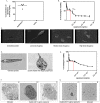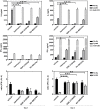Therapeutic control of leishmaniasis by inhibitors of the mammalian target of rapamycin
- PMID: 30133440
- PMCID: PMC6122837
- DOI: 10.1371/journal.pntd.0006701
Therapeutic control of leishmaniasis by inhibitors of the mammalian target of rapamycin
Abstract
Leishmaniasis is a serious global health problem affecting many people worldwide. While patients with leishmaniasis can be treated with several agents, drug toxicicty and the emergence of resistant strains render available treatments ineffective in the long run. Inhibitors of the mammalian target of rapamycin (mTOR) have been demonstrated to exert anti-pathogen properties. In this study, we tested the therapeutic efficacy of several mTOR inhibitors in controlling infection with Leishmania major. Rapamycin, GSK-2126458 and KU-0063794 were administered to BALB/c mice, which had received an intrafootpad injection of the parasite. Footpad swelling and parasite burden were assessed, and cytokine production by mouse splenocytes and phenotypic changes in draining lymph node cells were evaluated. Treatment with a clinically relevant dose of rapamycin or with GSK-2126458, but not with KU-0063794, dramatically lowered both the footpad swelling and the parasite load in the draining lymph node. Importantly, the employed dose of rapamycin did not kill the promastigotes in vitro as judged by 3-(4,5-dimethylthiazol-2-yl)-2,5-diphenyltetrazolium bromide (MTT) assays and electron microscopy. Moreover, the IL-4 production capacity of splenocytes harvested from infected mice that were treated with rapamycin was significantly reduced. Consequently, the IFN-γ:IL-4 production ratio was elevated, suggesting a T helper-type 1 (Th1)-skewed cytokine profile. Finally, the expression level of CD69, an early activation marker, on splenic and lymph node CD4+ and CD8+ T cells was enhanced in rapamycin-treated mice. Taken together, our findings suggest that select mTOR inhibitors may be used in therapeutic settings for the management of leishmaniasis. We propose that the beneficial effects of such inhibitors stem from their immunomodulatory properties. Therefore, the adjuvanticity of mTOR inhibitors may also be considered in vaccination strategies against Leishmania species.
Conflict of interest statement
The authors have declared that no competing interests exist.
Figures





Similar articles
-
Antileishmanial effect of rapamycin as an alternative approach to control Leishmania tropica infection.Vet Parasitol. 2019 Dec;276:108976. doi: 10.1016/j.vetpar.2019.108976. Epub 2019 Nov 10. Vet Parasitol. 2019. PMID: 31739256
-
Mammalian Target of Rapamycin Inhibition in Trypanosoma cruzi-Infected Macrophages Leads to an Intracellular Profile That Is Detrimental for Infection.Front Immunol. 2018 Feb 20;9:313. doi: 10.3389/fimmu.2018.00313. eCollection 2018. Front Immunol. 2018. PMID: 29515594 Free PMC article.
-
In vitro and in vivo antileishmanial activity of a fluoroquinoline derivate against Leishmania infantum and Leishmania amazonensis species.Acta Trop. 2019 Mar;191:29-37. doi: 10.1016/j.actatropica.2018.12.036. Epub 2018 Dec 23. Acta Trop. 2019. PMID: 30586571
-
Benefits of mTOR kinase targeting in oncology: pre-clinical evidence with AZD8055.Biochem Soc Trans. 2011 Apr;39(2):456-9. doi: 10.1042/BST0390456. Biochem Soc Trans. 2011. PMID: 21428919 Review.
-
Distinct immunological states in murine cutaneous leishmaniasis by immunising with different amounts of antigen: the generation of beneficial, potentially harmful, harmful and potentially extremely harmful states.Behring Inst Mitt. 1997 Feb;(98):153-9. Behring Inst Mitt. 1997. PMID: 9382736 Review.
Cited by
-
PI3K/AKT signaling in parasites and parasite diseases: Role and therapeutic potential.Virulence. 2025 Dec;16(1):2532803. doi: 10.1080/21505594.2025.2532803. Epub 2025 Jul 15. Virulence. 2025. PMID: 40643963 Free PMC article. Review.
-
Immunotherapeutic Strategies as Potential Treatment Options for Cutaneous Leishmaniasis.Vaccines (Basel). 2024 Oct 17;12(10):1179. doi: 10.3390/vaccines12101179. Vaccines (Basel). 2024. PMID: 39460345 Free PMC article. Review.
-
Autophagy Limits Inflammasome During Chlamydia pneumoniae Infection.Front Immunol. 2019 Apr 12;10:754. doi: 10.3389/fimmu.2019.00754. eCollection 2019. Front Immunol. 2019. PMID: 31031755 Free PMC article.
-
Isolation, characterization, and functional study of extracellular vesicles derived from Leishmania tarentolae.Front Cell Infect Microbiol. 2022 Aug 3;12:921410. doi: 10.3389/fcimb.2022.921410. eCollection 2022. Front Cell Infect Microbiol. 2022. PMID: 35992172 Free PMC article.
-
Translational profiling of macrophages infected with Leishmania donovani identifies mTOR- and eIF4A-sensitive immune-related transcripts.PLoS Pathog. 2020 Jun 1;16(6):e1008291. doi: 10.1371/journal.ppat.1008291. eCollection 2020 Jun. PLoS Pathog. 2020. PMID: 32479529 Free PMC article.
References
-
- Vendrame CM, Souza LD, Carvalho MD, Salgado K, Carvalho EM, et al. (2010) Insulin-like growth factor-I induced and constitutive arginase activity differs among isolates of Leishmania derived from patients with diverse clinical forms of Leishmania braziliensis infection. Transactions of the Royal Society of Tropical Medicine and Hygiene 104: 566–568. 10.1016/j.trstmh.2010.03.007 - DOI - PubMed
Publication types
MeSH terms
Substances
Grants and funding
LinkOut - more resources
Full Text Sources
Other Literature Sources
Medical
Research Materials
Miscellaneous

